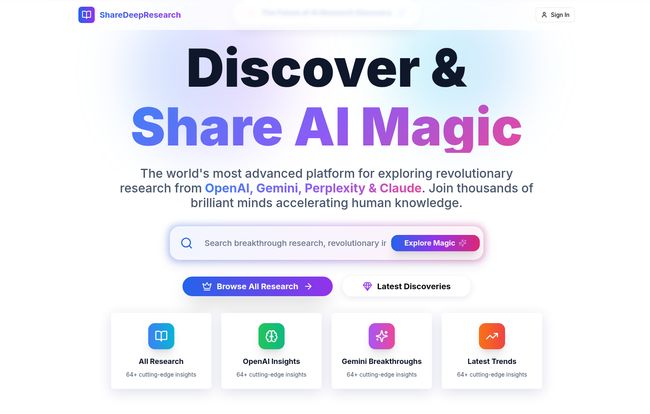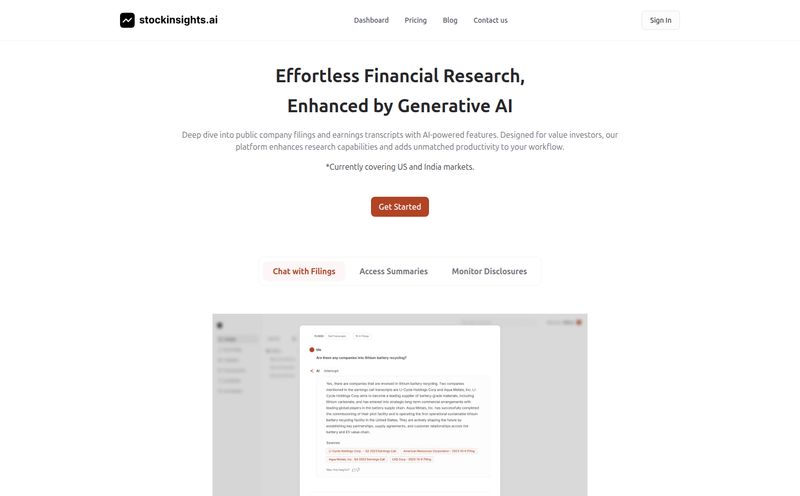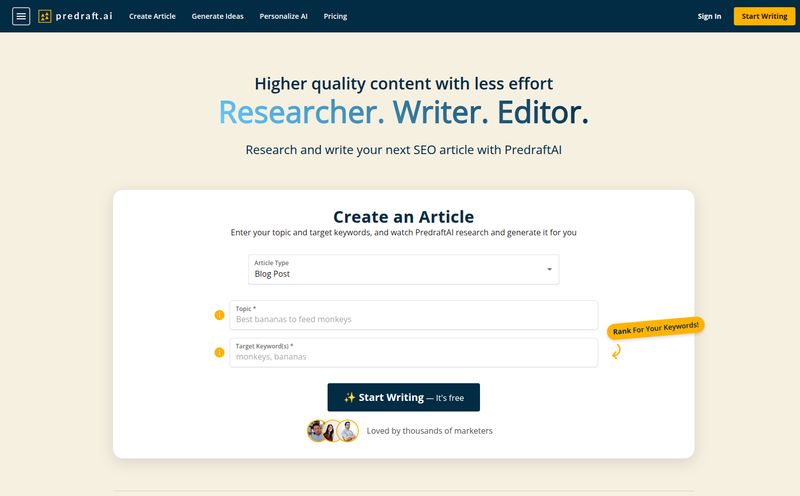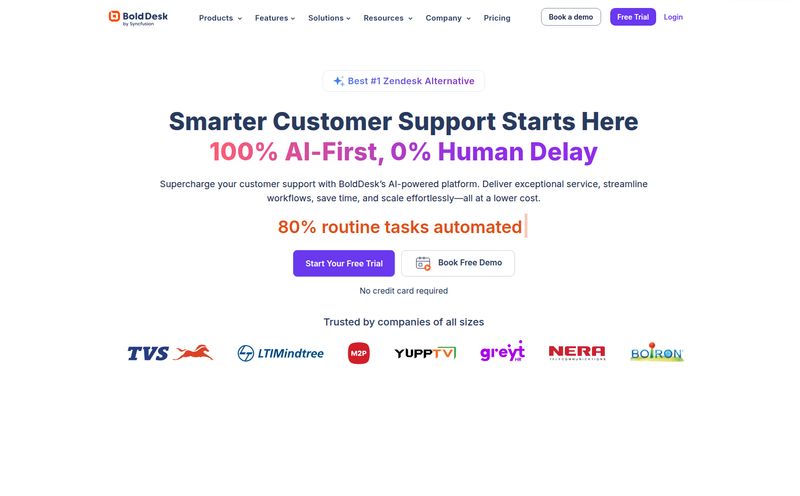If you're in any field that involves research—especially tech or AI—you know the feeling. It's like trying to drink from a firehose that's spewing out pre-print papers from arXiv, hot takes from X (the platform formerly known as Twitter), and about a dozen new models a week. Keeping up isn't just a full-time job; it's an impossible one.
For years, we've been stuck in our little silos. We have our institutional subscriptions, our favorite subreddits, and maybe a Slack group or two. But it’s all so… disconnected. Finding the signal in the noise feels like a Herculean task. I’ve lost count of the number of times I've stumbled upon a game-changing paper a month after it would have been most useful. Frustrating, right?
So when a platform like Share Deep Research pops up on my radar, my inner cynic and my inner optimist get into a fistfight. The cynic says, “Oh great, another platform.” But the optimist, the one who still believes technology can actually connect us, leans in a little closer. This one feels a bit different. It’s not just a repository; it’s positioning itself as a community, an AI-powered discovery engine, and a collaborative space all in one. Let's see if it's just smoke and mirrors or something genuinely useful.
So What Exactly Is Share Deep Research?
At its core, Share Deep Research is an AI-powered platform built for the express purpose of sharing and discovering research insights, particularly those generated by or about artificial intelligence. Think of it less like a dusty old library and more like a bustling, modern coffee shop where the smartest minds are hanging out, sharing their latest findings, and getting instant feedback.
The homepage throws some impressive numbers at you: over 25,000 research posts and a community of 13,000+ active researchers. That’s not a small user base. It suggests there's a real thirst for this kind of thing, and people are already diving in. They claim over 100,000 monthly insights are generated, which points to a very active ecosystem.
It's this community aspect that piques my interest. It’s one thing to have a database of papers. It's another thing entirely to have a living, breathing network of people actively discussing them.
The AI Engines Under the Hood
Okay, here’s where it gets really interesting for a tech nerd like me. The platform isn't just using some generic, in-house AI. It's plugging directly into the big guns of the AI world. This is like getting a car and finding out it has engines designed by Ferrari, Porsche, and Rolls-Royce. You have options, and they're all top-tier.
Connecting with OpenAI, Gemini, Claude, and Perplexity
The platform openly states it’s “Powered by Leading AI Platforms,” and it lists four key players:
- OpenAI: The creators of the GPT models we all know and love (or are terrified of). Share Deep Research mentions using it for “breakthrough conversations” and “code generation.” This suggests it can help not just with understanding text but also the technical, code-based aspects of research.
- Google Gemini: The new kid on the block that’s already making waves. The platform points to its “unprecedented capabilities” and “multi-modal reasoning.” This is huge. It means the platform can potentially understand not just text, but images, charts, and data within the research papers. That's a serious upgrade from your standard PDF reader.
- Perplexity: For those of us obsessed with accuracy and battling misinformation, Perplexity’s inclusion is a massive green flag. It’s known for real-time citations and fast verification. This could be the antidote to the hallucinations and made-up facts that sometimes plague other AI models. It brings a layer of trust.
- Claude: Anthropic’s AI is often praised for its “constitutional” approach and focus on ethical reasoning. In a field moving at lightning speed, having a built-in ethical compass to help parse and discuss research is more important than ever. It's a thoughtful inclusion.
By leveraging these different AIs, the platform is essentially building a Swiss Army knife for researchers. It's not just a search engine; it’s a summarizer, a code-interpreter, a fact-checker, and a discussion prompter rolled into one.

Visit Share Deep Research
Core Features That Actually Matter to Researchers
A flashy tech stack is great, but what does it actually do for the user? Based on their site, the experience boils down to a few key features that seem genuinely designed to solve real-world reseacrh problems.
First up is the AI-Powered Discovery. Instead of you hunting for papers with clunky keyword searches, the platform uses its AI brains to intelligently categorize everything. This means you find what you need faster. This is paired with Personalized Discovery, which is basically a “For You” page for academic work. The more you use it, the better it gets at showing you papers, insights, and discussions that align with your specific interests. Heaven.
Then there’s the Lightning-Fast Processing. We’ve all been there—staring at a dense, 40-page paper and wondering if it’s worth the two-hour time investment. This feature promises to extract key insights and generate summaries automatically. If this works as well as advertised, it's a monumental time-saver.
Finally, the Global Research Network. This is the human element. It’s about connecting you with those 13,000+ other researchers. It’s about turning the solitary act of reading into a collaborative act of discussion and discovery. I’ve had some of my biggest breakthroughs just by chatting with a colleague about a new concept. This platform wants to digitize that experience, and I'm here for it.
The Million-Dollar Question: What's the Catch?
Alright, let's bring the cynic back in for a moment. No platform is perfect. From the outside, there are a few potential wrinkles.
The technical bits, like requiring JavaScript and cookie consent, are pretty standard fare these days, so that's a non-issue for most. A more valid point is that while the platform boasts about sharing insights, it's a little vague on what specific tools it offers researchers beyond discovery and summarization. Is there a collaborative writing space? Data visualization tools? The potential is there, but the specifics are a bit fuzzy.
And now for the big one: the price. How much does it cost? The answer is... ¯\_(ツ)_/¯. There is no pricing information available on the main page. I even tried to find a pricing page and hilariously ran into a "404 This page could not be found" error. Maybe that’s a joke? Or maybe it’s a sign that the platform is currently free for academics and researchers to build its user base—a common strategy. This could be a huge pro, but the lack of transparency is a bit of a head-scratcher. My gut says it’s likely free for individual researchers with a potential future enterprise tier for institutions or corporate R&D teams.
Who Should Be Using This Right Now?
Despite the few question marks, it's pretty clear who stands to benefit from Share Deep Research.
- PhD students and Postdocs: You are the prime audience. You're living in the literature and need to stay on the absolute cutting edge. This could save you hundreds of hours a year.
- University Academics and Professors: A great way to see what's trending outside your immediate circle and find potential collaborators for cross-disciplinary projects.
- R&D Teams in Tech Companies: Your job is to turn theoretical research into practical applications. A platform that summarizes and categorizes the latest AI breakthroughs is a goldmine.
- Independent Researchers & AI Enthusiasts: If you're serious about learning but don't have a massive institutional budget, a (presumably) free platform like this is your gateway to the global conversation.
My Honest Take as a Long-Time SEO and Tech Watcher
So, is Share Deep Research a true game-changer? It has all the right ingredients. The problem it's trying to solve—information overload and research isolation—is one of the biggest pain points in modern knowledge work. Its approach, leveraging a suite of powerful, specialized AIs and fostering a community, is incredibly smart.
It feels like a mashup of arXiv, ResearchGate, and a highly-intelligent Reddit, with a user experience designed for this decade. The fact that it integrates tools like Perplexity for verification shows a commitment to quality that many platforms overlook. Some might say it's just another aggregator, but I think the AI-powered summarization and personalization layers make it something more.
I believe its success will hinge on the quality of its community and its ability to keep the signal-to-noise ratio high. If it can become the go-to place for serious discussion, it won't just be a useful tool; it'll become an indispensable part of the research lifecycle.
A Step in the Right Direction for Collaborative Science
In a world drowning in data, curation and connection are the most valuable commodities. Share Deep Research seems to understand this deeply. It’s an ambitious project that’s tackling a massive problem, and it seems to be doing it with the right technology and the right philosophy.
While I still have questions about its long-term business model and the full depth of its feature set, I’m genuinely excited by its potential. It represents a move away from siloed, gate-kept knowledge and toward a more open, connected, and AI-accelerated future for research. And that's something I think we can all get behind.
Frequently Asked Questions
1. What is Share Deep Research?
Share Deep Research is an AI-powered collaboration platform where researchers can share, discover, and discuss research insights. It uses leading AI models to help users find relevant information, summarize complex papers, and connect with a global community of academics and experts.
2. How much does Share Deep Research cost?
Currently, there is no public pricing information available on the Share Deep Research website. This often suggests that the platform may be free for individual users, at least for now, as it focuses on growing its community.
3. What AI models does the platform use?
The platform integrates several advanced AI systems, including OpenAI's GPT models for conversation and code, Google's Gemini for multi-modal reasoning, Perplexity for real-time verification and citations, and Anthropic's Claude for its focus on ethical reasoning.
4. Is Share Deep Research only for AI researchers?
While its initial focus and many of its examples are centered on AI, the platform's structure could benefit researchers in any field experiencing a high volume of new publications, such as biotech, climate science, or social sciences. The examples on the homepage cover topics from AI technology to funding opportunities.
5. How is this different from ArXiv or Google Scholar?
ArXiv is primarily a pre-print server (a repository for papers), and Google Scholar is a search engine. Share Deep Research aims to be more interactive. It adds layers of AI-powered summarization, personalized discovery, and a built-in community network for discussion, making it more of a collaborative ecosystem than a simple database or search tool.
6. Can I upload and share my own research on the platform?
Yes, the platform is designed for sharing. The main call to action is "Start Sharing Research," indicating that a core function is for users to upload their own findings and insights to engage with the community.
Reference and Sources
- Information and screenshots sourced from the Share Deep Research official website.
- OpenAI
- Google Gemini
- Perplexity AI
- Anthropic (Claude)
- arXiv.org
- ResearchGate



